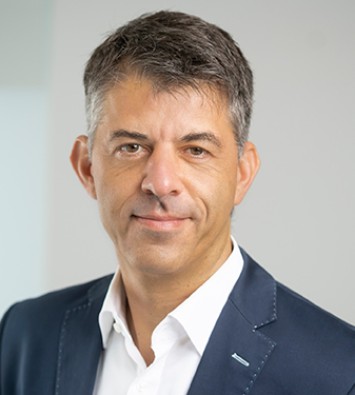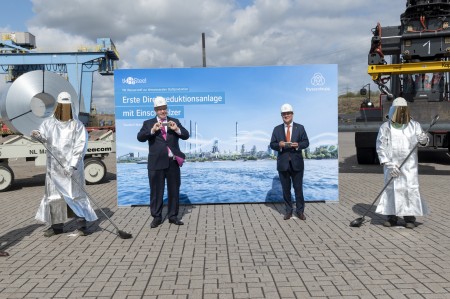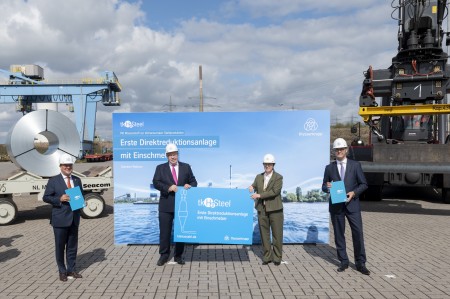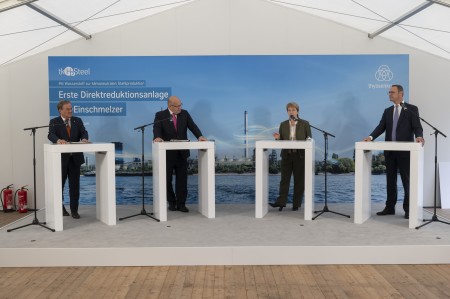Daily press, 2020-08-28, 12:00 pm
Electrical hot metal from blast furnace 2.0: thyssenkrupp presents Federal Economics Minister Altmaier and State Premier Laschet innovative concept for green transformation of Duisburg steel mill
The green transformation of Germany’s largest steel producer is taking shape. Today, thyssenkrupp’s CEO Martina Merz presented Federal Economics Minister Peter Altmaier and North Rhine-Westphalia’s State Premier Armin Laschet the concept for the construction of the first direct reduction plant with an integrated melting unit (blast furnace 2.0) at the Duisburg site.
Federal Economics Minister Peter Altmaier: “Today, thyssenkrupp is sending a strong signal for ambitious industrial climate protection. Steel is a key German industry. We must do everything we can to ensure that climate-friendly and competitive green steel is produced in Germany in the future. With the Handlungskonzept Stahl (Steel Action Plan), we have defined the framework conditions. Now it's a matter of translating them into concrete projects. The planned direct reduction plant is an excellent example for this“.
Armin Laschet, State Premier of North Rhine-Westphalia: “With its uniquely dense and networked corporate and research landscape, North Rhine-Westphalia is an ideal location to move forward and become a model for a European center for the development of climate-neutral industries. This is also reflected in this trend-setting project at the Duisburg steel location: thyssenkrupp has the opportunity to write industrial history once again if the company resolutely moves forward in its transformation to a climate-neutral industry and the development of green steel. We as politicians will support the industry in this. This is a challenge for everyone: Federal and state governments, but also the European Union.”
The currently unique concept of this type holds a number of advantages. It is largely based on the existing structures of Europe’s largest integrated steel production site, which means that considerably less investment and operating costs are involved. Another important advantage for the customers is the maintenance of the complete product portfolio, as the existing steel mills and processes can still be used. This efficient path towards climate-neutrality is enabled by an innovation: The solid material produced in the direct reduction plant is liquefied in an integrated melting unit. This blast furnace 2.0 produces “electrical hot metal”, which is processed in the existing metallurgical plant in an energy-efficient manner. The integrated direct reduction plant is to be operated with green hydrogen and green power in future and is an important step towards the achievement of the climate goals of the company and those defined by the Paris Agreement. thyssenkrupp has set itself the target to reduce its CO2 emissions by 30 percent by 2030 and plans to complete the main part of the plant by 2025 and produce 400,000 tonnes of green steel. For 2030, the company aims at 3 million tonnes of climate-neutral steel.
Enormous potential of the steel industry for effective climate protection
The Duisburg steel production site currently accounts for around two percent of CO2 emissions in Germany. The potential for reducing CO2 is also of this magnitude if these emissions can be reduced to zero in the long term. To this end, thyssenkrupp is focusing above all on hydrogen: Tests are currently being conducted to use hydrogen in conventional blast furnace operation with the aim of reducing the CO2 footprint of steel production in the short term and producing the first quantities of CO2-neutral steel. The next milestone will be the construction of a novel integrated direct reduction plant, which allows emissions to be significantly reduced.
thyssenkrupp’s CEO Martina Merz: “Our steel experts have presented a technologically sophisticated integrated climate concept for the largest steel production site in Europe. Based on this concept, we will set out the details for the sustainable transformation of our production by the beginning of 2021 as part of an implementation study. The concept will send out a strong signal far beyond Duisburg. We agree with the politicians that no company can shoulder the transformation alone. We need appropriate support and incentive instruments in the first instance”.
Strengthening of competitiveness and strong signal for Duisburg and NRW
Another advantage of the concept is the strengthening of the Duisburg location. The Rhine-Ruhr area offers all the conditions for implementing the transformation along the steel value chain efficiently and sustainably.
Another important advantage of the concept, which is presented today, is the comparably fast ramp-up of climate-neutral steel production. The first direct reduction plant with melting unit will have an annual production capacity of 1.2 million tonnes. As long as hydrogen is not available in sufficient quantities, the plant can be operated with natural gas. This will already allow to reduce CO2 emissions considerably and to produce significant amounts of green steel – without compromising the quality of the products. “We can operate our planned blast furnace 2.0, which is integrated into the metallurgical plant more cost-effectively than on a greenfield site. This is one of the many advantages of the Duisburg location“, explains Bernhard Osburg, Chairman of the Executive Board of thyssenkrupp Steel. “We want to supply our customers with CO2-free steel via this green production route – in the usual grades and across the entire product portfolio. thyssenkrupp Steel can become the center of the green industrial transition in the Rhine-Ruhr area, because we are the starting point for numerous value chains. We want to use this ecosystem. We are ready to go“.







